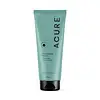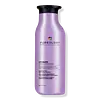What's inside
What's inside
 Key Ingredients
Key Ingredients

No key ingredients
 Benefits
Benefits

 Concerns
Concerns

 Ingredients Side-by-side
Ingredients Side-by-side

Water
Skin ConditioningSodium Lauroyl Methyl Isethionate
CleansingCocamidopropyl Betaine
CleansingGlycerin
HumectantAloe Barbadensis Leaf Juice
Skin ConditioningArgania Spinosa Kernel Oil
EmollientCucurbita Pepo Seed Oil
EmollientRubus Fruticosus Fruit Extract
AstringentChamomilla Recutita Flower Extract
MaskingEuterpe Oleracea Fruit Extract
Rosa Canina Fruit Extract
AstringentCalendula Officinalis Flower Extract
MaskingAspalathus Linearis Leaf Extract
Skin ConditioningPunica Granatum Extract
AstringentCinnamomum Cassia Bark Extract
MaskingPrunus Amygdalus Dulcis Seed Extract
Skin ConditioningLevulinic Acid
PerfumingSodium Levulinate
Skin ConditioningGuar Hydroxypropyltrimonium Chloride
Skin ConditioningBenzaldehyde
MaskingCocoglucosides Hydroxypropyltrimonium Chloride
CleansingSodium Cocoyl Glutamate
CleansingSodium Methyl Cocoyl Taurate
CleansingBetaine
HumectantPotassium Sorbate
PreservativeSodium Benzoate
MaskingCitric Acid
BufferingSodium Hydroxide
BufferingWater, Sodium Lauroyl Methyl Isethionate, Cocamidopropyl Betaine, Glycerin, Aloe Barbadensis Leaf Juice, Argania Spinosa Kernel Oil, Cucurbita Pepo Seed Oil, Rubus Fruticosus Fruit Extract, Chamomilla Recutita Flower Extract, Euterpe Oleracea Fruit Extract, Rosa Canina Fruit Extract, Calendula Officinalis Flower Extract, Aspalathus Linearis Leaf Extract, Punica Granatum Extract, Cinnamomum Cassia Bark Extract, Prunus Amygdalus Dulcis Seed Extract, Levulinic Acid, Sodium Levulinate, Guar Hydroxypropyltrimonium Chloride, Benzaldehyde, Cocoglucosides Hydroxypropyltrimonium Chloride, Sodium Cocoyl Glutamate, Sodium Methyl Cocoyl Taurate, Betaine, Potassium Sorbate, Sodium Benzoate, Citric Acid, Sodium Hydroxide
Water
Skin ConditioningSodium Cocoyl Isethionate
CleansingDisodium Laureth Sulfosuccinate
CleansingSodium Lauryl Sulfoacetate
CleansingSodium Lauroyl Taurate
CleansingSarcosine
Skin ConditioningGlycol Distearate
EmollientCocamidopropyl Betaine
CleansingGlycereth-26
HumectantDecyl Glucoside
CleansingCoconut Acid
CleansingSodium Hydroxide
BufferingSodium Isethionate
CleansingParfum
MaskingCitric Acid
BufferingPPG-5-Ceteth-20
EmulsifyingDivinyldimethicone/Dimethicone Copolymer
Sodium Chloride
MaskingPolyquaternium-7
Amodimethicone
Coco-Betaine
CleansingPolyquaternium-10
Propylene Glycol
HumectantPEG-55 Propylene Glycol Oleate
Linalool
PerfumingCarbomer
Emulsion StabilisingC11-15 Pareth-7
EmulsifyingBenzoic Acid
MaskingLaureth-9
EmulsifyingButylene Glycol
HumectantGlycerin
HumectantLimonene
PerfumingGeraniol
PerfumingTocopherol
AntioxidantBenzyl Alcohol
PerfumingTrideceth-12
EmulsifyingSalicylic Acid
MaskingSodium Benzoate
MaskingHelianthus Annuus Seed Extract
Skin ConditioningMagnesium Nitrate
C12-13 Pareth-23
CleansingC12-13 Pareth-3
EmulsifyingBenzophenone-4
UV AbsorberTetrasodium EDTA
Phenoxyethanol
PreservativeHydroxypropyltrimonium Hydrolyzed Wheat Protein
Skin ConditioningWheat Amino Acids
Skin ConditioningHydrolyzed Vegetable Protein Pg-Propyl Silanetriol
Skin ConditioningCI 60730
Cosmetic ColorantCI 60725
Cosmetic ColorantMethylchloroisothiazolinone
PreservativeHydrolyzed Soy Protein
HumectantSorbic Acid
PreservativeMagnesium Chloride
Methylisothiazolinone
PreservativePotassium Sorbate
PreservativeDisodium EDTA
Helianthus Annuus Seed Oil
EmollientAscorbic Acid
AntioxidantCamellia Sinensis Leaf Extract
AntimicrobialRosa Centifolia Flower Extract
AstringentAloe Barbadensis Leaf Extract
EmollientWater, Sodium Cocoyl Isethionate, Disodium Laureth Sulfosuccinate, Sodium Lauryl Sulfoacetate, Sodium Lauroyl Taurate, Sarcosine, Glycol Distearate, Cocamidopropyl Betaine, Glycereth-26, Decyl Glucoside, Coconut Acid, Sodium Hydroxide, Sodium Isethionate, Parfum, Citric Acid, PPG-5-Ceteth-20, Divinyldimethicone/Dimethicone Copolymer, Sodium Chloride, Polyquaternium-7, Amodimethicone, Coco-Betaine, Polyquaternium-10, Propylene Glycol, PEG-55 Propylene Glycol Oleate, Linalool, Carbomer, C11-15 Pareth-7, Benzoic Acid, Laureth-9, Butylene Glycol, Glycerin, Limonene, Geraniol, Tocopherol, Benzyl Alcohol, Trideceth-12, Salicylic Acid, Sodium Benzoate, Helianthus Annuus Seed Extract, Magnesium Nitrate, C12-13 Pareth-23, C12-13 Pareth-3, Benzophenone-4, Tetrasodium EDTA, Phenoxyethanol, Hydroxypropyltrimonium Hydrolyzed Wheat Protein, Wheat Amino Acids, Hydrolyzed Vegetable Protein Pg-Propyl Silanetriol, CI 60730, CI 60725, Methylchloroisothiazolinone, Hydrolyzed Soy Protein, Sorbic Acid, Magnesium Chloride, Methylisothiazolinone, Potassium Sorbate, Disodium EDTA, Helianthus Annuus Seed Oil, Ascorbic Acid, Camellia Sinensis Leaf Extract, Rosa Centifolia Flower Extract, Aloe Barbadensis Leaf Extract
 Reviews
Reviews

Ingredients Explained
These ingredients are found in both products.
Ingredients higher up in an ingredient list are typically present in a larger amount.
Citric Acid is an alpha hydroxy acid (AHA) naturally found in citrus fruits like oranges, lemons, and limes.
Like other AHAs, citric acid can exfoliate skin by breaking down the bonds that hold dead skin cells together. This helps reveal smoother and brighter skin underneath.
However, this exfoliating effect only happens at high concentrations (20%) which can be hard to find in cosmetic products.
Due to this, citric acid is usually included in small amounts as a pH adjuster. This helps keep products slightly more acidic and compatible with skin's natural pH.
In skincare formulas, citric acid can:
While it can provide some skin benefits, research shows lactic acid and glycolic acid are generally more effective and less irritating exfoliants.
Most citric acid used in skincare today is made by fermenting sugars (usually from molasses). This synthetic version is identical to the natural citrus form but easier to stabilize and use in formulations.
Read more about some other popular AHA's here:
Learn more about Citric AcidCocamidopropyl Betaine is a fatty acid created by mixing similar compounds in coconut oil and dimethylaminopropylamine, a compound with two amino groups.
This ingredient is a surfactant and cleanser. It helps gather the dirt, pollutants, and other impurities in your skin to be washed away. It also helps thicken a product and make the texture more creamy.
Being created from coconut oil means Cocamidopropyl Betaine is hydrating for the skin.
While Cocamidopropyl Betaine was believed to be an allergen, a study from 2012 disproved this. It found two compounds in unpure Cocamidopropyl Betaine to be the irritants: aminoamide and 3-dimethylaminopropylamine. High-grade and pure Cocamidopropyl Betaine did not induce allergic reactions during this study.
Learn more about Cocamidopropyl BetaineGlycerin is already naturally found in your skin. It helps moisturize and protect your skin.
A study from 2016 found glycerin to be more effective as a humectant than AHAs and hyaluronic acid.
As a humectant, it helps the skin stay hydrated by pulling moisture to your skin. The low molecular weight of glycerin allows it to pull moisture into the deeper layers of your skin.
Hydrated skin improves your skin barrier; Your skin barrier helps protect against irritants and bacteria.
Glycerin has also been found to have antimicrobial and antiviral properties. Due to these properties, glycerin is often used in wound and burn treatments.
In cosmetics, glycerin is usually derived from plants such as soybean or palm. However, it can also be sourced from animals, such as tallow or animal fat.
This ingredient is organic, colorless, odorless, and non-toxic.
Glycerin is the name for this ingredient in American English. British English uses Glycerol/Glycerine.
Learn more about GlycerinPotassium Sorbate is a preservative used to prevent yeast and mold in products. It is commonly found in both cosmetic and food products.
This ingredient comes from potassium salt derived from sorbic acid. Sorbic acid is a natural antibiotic and effective against fungus.
Both potassium sorbate and sorbic acid can be found in baked goods, cheeses, dried meats, dried fruit, ice cream, pickles, wine, yogurt, and more.
You'll often find this ingredient used with other preservatives.
Learn more about Potassium SorbateSodium Benzoate is a preservative. It's used in both cosmetic and food products to inhibit the growth of mold and bacteria. It is typically produced synthetically.
Both the US FDA and EU Health Committee have approved the use of sodium benzoate. In the US, levels of 0.1% (of the total product) are allowed.
Sodium benzoate works as a preservative by inhibiting the growth of bacteria inside of cells. It prevents the cell from fermenting a type of sugar using an enzyme called phosphofructokinase.
It is the salt of benzoic acid. Foods containing sodium benzoate include soda, salad dressings, condiments, fruit juices, wines, and snack foods.
Studies for using ascorbic acid and sodium benzoate in cosmetics are lacking, especially in skincare routines with multiple steps.
We always recommend speaking with a professional, such as a dermatologist, if you have any concerns.
Learn more about Sodium BenzoateSodium Hydroxide is also known as lye or caustic soda. It is used to adjust the pH of products; many ingredients require a specific pH to be effective.
In small amounts, sodium hydroxide is considered safe to use. However, large amounts may cause chemical burns due to its high alkaline.
Your skin has a natural pH and acid mantle. This acid mantle helps prevent harmful bacteria from breaking through. The acid mantle also helps keep your skin hydrated.
"Alkaline" refers to a high pH level. A low pH level would be considered acidic.
Learn more about Sodium HydroxideWater. It's the most common cosmetic ingredient of all. You'll usually see it at the top of ingredient lists, meaning that it makes up the largest part of the product.
So why is it so popular? Water most often acts as a solvent - this means that it helps dissolve other ingredients into the formulation.
You'll also recognize water as that liquid we all need to stay alive. If you see this, drink a glass of water. Stay hydrated!
Learn more about Water